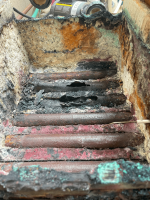I think I've read the majority of the posts here with Hayward and IF code, and after a few days wrestling with this, I'm stuck on the next part.
Pool opened early June, and the heater's been working fine since (had to clear out a LO code by cleaning contacts, but that's not relevant). The heater is now going to IF mode after a few cycles of firing up and dying out, and the timing is random. Sometimes it stays on for up to 15-20 seconds, sometimes it lasts only a few seconds.
So here's what I've done so far to diagnose the IF code, using the Hayward Universal H-Series Troubleshooting Guide:
Pool opened early June, and the heater's been working fine since (had to clear out a LO code by cleaning contacts, but that's not relevant). The heater is now going to IF mode after a few cycles of firing up and dying out, and the timing is random. Sometimes it stays on for up to 15-20 seconds, sometimes it lasts only a few seconds.
So here's what I've done so far to diagnose the IF code, using the Hayward Universal H-Series Troubleshooting Guide:
- First pass: Opened up the heater and cleaned and vacuumed pretty much everywhere. There was a lot of rust build up on the top heat fins of the exchanger. Cycled via front buttons and it seemed to stay on for much longer than before. It was up for 10 minutes before I reinstalled the front panel, and then it stopped. I reopened the panel but then it went into the firing and stopped cycle before ending in IF code. It might have been a coincidence with the front panel.
- Second pass: Cleaned the flame igniter and its cover and saw igniter glow properly when calling for heat. Still does the firing and stopping cycle before settling on IF code.
- Third pass: Took off blower to access flame sensor. Cleaned blower base plate and area around flame sensor plate. Cleaned flame sensor contact and tested resistance and continuity. Installed new flame sensor and reinstalled blower. Still same firing and stopping cycle before ending in IF code. Blower air inlet plate does not look damaged. Silly question - is this supposed to blow air out from the "inlet plate side" (grill with square holes)?
- Fourth pass: Took apart gas union (it was stuck something fierce..), removed orifices from detached manifold and cleaned them (none of the orifices were blocked). None of the holes of the manifold seemed to be blocked either. Cycled back to bo code and it's still doing its firing up and stopping cycle before ending up in IF code.
- Fifth pass: Finally got the manometer, and here's where I'm stuck. I have a plastic tube that fits over the manometer port, but I don't know how to connect it to the gas valve. In page 16 of the guide, it shows these brass looking connectors. What the heck are these? My manometer came with just a tube and no other accessories.
- Anyway, that's where I'm stuck at. What's the part that I need to pick up to connect the manometer tube to this port to test it out? I'm really hoping I don't have to replace the gas valve at this point.
- If I'm getting correct voltage, that means the ICB is working properly, right?
- Some other observations: Flame viewport needs cleaning. I didn't even realize it was one till my last pass at it. There is some slight condensation under the air box, and the flame when lit seems yellow.
- One last thing, are there official replacement hex head screws? These are what I'm pulling out of the system, and I found some #10 1/2" metal hex screws at the hardware store:














